
To change your log-in password;
1.Go to your “Profile”
2. scroll down to “New Password”
3. Type your new password in twice then “Update Profile”
Keepers Resources

To change your log-in password;
1.Go to your “Profile”
2. scroll down to “New Password”
3. Type your new password in twice then “Update Profile”
Welcome Amazing Goalkeeper,
Thanks for joining us on the OBO Keepers Resources 2.0. We have worked hard to provide you with a new improved goalkeepers resource that will enable you to share what you find, contribute your knowledge and learn from other keepers all over the world on playing better and having more fun!
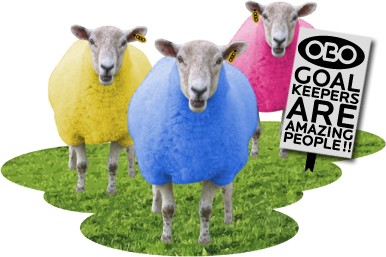
If this is your first time to OBO Keepers Resources we strongly recommend you view the flash presentations located on the links below to familiarise yourself with how the website works;
Basic navigation of the Keepers Resources Website
How to Use the Keepers Resources Dashboard
How to add a new post/ article to this website.
Some other posts that may be useful are:
How to change your Log In Password
How to get your own custom Avatar
We are not big on rules around OBO, in fact we have broken a few in our time. But please; keep it positive never negative, keep it helpful never personal and always show respect.
Cheers,
Simon B
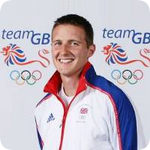
Alistair McGregor is the current Loughborough Students and Great Britain goalkeeper. As an OBO sponsored player has requested to test out the Knees Up knee protector…here is his review:
“I have been using the knee pads for the past few months now and have been very impressed by them. I got a direct hit off them during a shooting session, obviously at the time the initial impact still hurt, however i was able to continue with the session. Having been hit on the knee before with other knee pads i have suffered a bit of stiffness from the impact. I feel that with the OBO knee pads that the stiffness from the injury was far less and only received a very small mark were the ball hit me. The foam in the knee pads seemed to dispel a lot of the impact of the shot. I fully appreciate that the thickness of the foam is difficult to get right, i feel that this is very close to being an excellent knee pad. The knee pads sit well with the shorts and the open knee area helps to keep them in place. A possible addition could be a plastic/harder thin material inside the knee pad to provide even greater protection.”
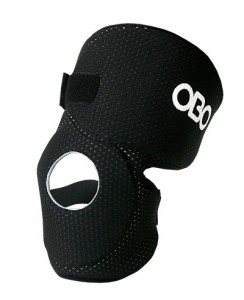
” The knee pads do hold the water quite a lot when wet, however overall I have been very impressed with the knee pads and will be using them in the Olympics. I feel that the knee pads give me that little bit of extra confidence when facing some of the hardest hitters of the ball in the world.”
Thanks for all your support,
Ali

CRASH TEST: The air cannon used in impact testing at the OBO laboratory in Palmerston North.
The Antipodean collider is actually a form of air cannon used in testing helmets, face masks and other protective gear developed by the Palmerston North-based sports equipment manufacturer, OBO.
OBO is now well into the design and prototype construction stages of developing a new mask, for which the company has received a boost of $217,000 from the Foundation for Research, Science and Technology.
Company founder Simon Barnett said the mask is able to take a direct frontal hit from a ball spat out by the cannon at 160kmh.
He said OBO wasn’t interested in mass- producing “one size fits all” helmets or masks, but preferred to concentrate on smaller, niche markets with equipment designed for specific purposes.
The initial focus was on face protection for players in cricket, softball and hockey and Mr Barnett and his company are high in their praises of goalies everywhere and believe the security their masks offer boosts confidence.
The new mask fits the niche market philosophy well.
For example, OBO has protective gear designed specifically for hockey goalkeepers, and for softball pitchers and cricket wicketkeepers.
“In hockey we have existing face protectors for short-corner protection and during the running phase of the game, but we wanted to improve on it,” he said.
A need was identified for frontal face protection without “the full drama and protection of a helmet that just adds weight and heat.”
Mr Barnett was particularly critical of cricket face protectors which “gave” sufficiently to allow serious injuries such as that suffered by Black Cap Daniel Flynn last year.
OBO’s new mask, being developed in association with designer Rob Whitfield, employs materials and features about which the security- conscious company is not saying much at this stage.
However, the first of the helmets should be ready for assessment by sportspeople in March next year. The company will then consider this last-minute advice in any fine- tuning before going into production.
Mr Barnett said the prototype of the mask offered good visibility – “almost complete peripheral vision” – and because of the materials used and shapes and angles of the parts, could withstand a direct frontal hit from a ball travelling at 160kmh.
The air cannon in the developmental laboratory was coupled with a camera capable of taking 20,000 images a second, allowing a detailed analysis of the actions of ball and mask under impact.
So impressive has the mask been to date that possible applications have emerged in police riot gear.
But Mr Barnett said any police application was “further down the track” and would involve designing a new helmet under the company’s purpose-build philosophy.
OBO began in 1994 with a dedicated range of equipment for hockey goalkeepers under its own brand name. Although global expansion had been rapid, OBO had not forgotten its origins, said Mr Barnett.
“Almost all of our production is still done in Palmerston North.”
Via www.stuff.co.nz
Media release, 7 May 2008, Nightside Test Design Ltd, Christchurch, New Zealand: Christchurch based company test engineering company Nightside Test Design is showcasing slow motion video clips of their latest vision and data project at the EMEX trade show currently running in Auckland, demonstrating the impact of cricket and hockey balls on standard sports helmets.
Media release, 7 May 2008, Nightside Test Design Ltd, Christchurch, New Zealand: Christchurch based company test engineering company Nightside Test Design is showcasing slow motion video clips of their latest vision and data project at the EMEX trade show currently running in Auckland, demonstrating the impact of cricket and hockey balls on standard sports helmets.
Nightside’s managing director, Peter Brown, says the sports equipment test laboratory recently completed for Palmerston North manufacturers OBO is designed to reduce the number of head injuries among players of ball sports.
OBO specialise in protective equipment for field hockey goalies and have a 65% share of the world market, exporting to 61 countries.
“In the last fifteen years, the speed of balls being hit, thrown or bowled at players has increased exponentially, as a result of the improving technologies involved in surfaces and materials in bats, racquets, and hockey sticks.
“We have also seen a number of serious head injuries to sportspeople resulting from balls hitting the head at high speeds.
“Unfortunately the technology around testing to make sure protective helmets are up to par has not increased at the same speed – until now,” Brown says.
The new OBO test laboratory will start to address the issue, by providing a state of the art facility equipped with a high speed video camera and sensor equipment that captures and analyses the impact of balls shot by a high pressure cannon at up to 160km/h towards a test dummy head.
The shock attenuation of the impact is recorded frame by frame by the high speed Mikrotron video camera and other sensors at over 2,000 frames per second, allowing highly detailed analysis of the data and images around the impact zone.
To date, most similar testing has been limited to the automotive industry (using crash test dummies) and the military sector and is specific to the requirements of those industries.
Reuben Parr from OBO says the system has been very successful to date in testing a range of helmets and masks from different sporting codes, including cricket, softball and field hockey.
Results show a large difference in the performance of different products and different materials, for example, polycarbonate face masks proved to be far stronger than steel wire face masks used in a number of sports.
About OBO:
New Zealand manufacturer and exporter OBO is in the business of making protective gear for field hockey goalies. Based in Palmerston North, the company designs and manufactures a range of padding, masks, helmets, sticks and protective clothing primarily made from closed cell polyethylene foam.
OBO currently has more than 65% worldwide market share, exporting products to 61 countries.
More about OBO and their product range can be found at www.obo.co.nz
About Nightside Test Design Founded in 2001, Nightside Test Design provides independent embedded software test solutions as an alternative to having an in-house testing department. Accurate and timely testing can help streamline the development cycle while improving time to market, product reliability and efficiency. Nightside’s professional services cover the full product development lifecycle from design to production, including Software Testing, Production Testing, Embedded Development, Industrial Control, Measurement and Data Logging. Nightside is a member of the National Instruments Alliance Partner Program – an international network of consultants, systems integrators, and product developers that help bring NI technology to new applications and markets.
As one of only two Certified Alliance Partners in New Zealand, Nightside uses NI LabVIEW, LabWindows/CVI, and TestStand, along with the NI data acquisition and control hardware to provide automated solutions for manufacturing production test applications. Nightside Test Design’s range of services and products can be found at
Whether it is the New Year, the holidays, or just the opportunity to look back, life presents us with a chance to take stock of all we have. One of my all-time favorite books (and movies) is Pay It Forward. The story revolves around a boy’s class project, the concept of what we can realize if we pass on the good that comes to us. Many of us have been given a great many gifts. I’ll speak for myself and say many of my greatest gifts have come through sport. In the spirit of passing on what we have and the chance to give back, I offer a list of how we can play it forward.
Whether it is the New Year, the holidays, or just the opportunity to look back, life presents us with a chance to take stock of all we have. One of my all-time favorite books (and movies) is Pay It Forward. The story revolves around a boy’s class project, the concept of what we can realize if we pass on the good that comes to us. Many of us have been given a great many gifts. I’ll speak for myself and say many of my greatest gifts have come through sport. In the spirit of passing on what we have and the chance to give back, I offer a list of how we can play it forward. In no particular order:
1. Shake your opponents’ hands after every game.
2. Encourage your teammates (even after they’ve screwed up and especially if it resulted in a goal).
3. Coach a youth team.
4. Train hard when you don’t feel like it.
5. Let your teammates know when they’ve done something good in training (even when it’s scoring on you).
6. Take a younger keeper under your wing. Train with them. Go to their games, encourage them.
7. Pass on your old equipment.
8. If you’ve got equipment that you’re going to throw out, salvage what’s usable, buckles, straps, bolts, screws, etc. Give it to a youth program.
9. If you’re handy, offer to help them repair their gear.
10. Show a younger keeper how to take care of their equipment.
11. Support your country’s national team.
12. Umpire.
13. Don’t yell at umpires.
14. Thank an umpire for their time and efforts.
15. Thank your coach.
16. Live with passion.
17. Add to this list.
I’m indebted to a number of people through hockey who’ve helped me along the way as a coach, a player and a person. Now there are too many to list here, but thank you all. Special thanks to Simon and Mike and all the folks at OBO. Not only do they work to make better hockey players with their equipment, they make hockey better through their work.
All the best in 2008,
Jon
Goalkeepers are amazing people!!!
email Jon
Please note that OBO together with Jon O’Haire hold copyright over any material appearing on tips pages. We welcome the printing and distribution of these tips, provided that they are not sold, or used for financial gain. This paragraph must appear on all printed or distributed copies. Any photographs above must not be used in any form without express permission from Jon O’Haire.
There was a day when any lifted shot at goal had to be controlled and cleared by the keeper. Control meant stopping the ball and dropping it straight down to clear. Keepers were required to wear gloves and essentially had to catch the shot without closing their hand on the ball and drop it down. Opposing forwards knew exactly where the first save had to go and were quick to pounce on the dropped shot. If the equipment made the job difficult enough, the consequences of bad technique made the lifted shot brutal. If your save caused the ball to be pushed or deflected you were rewarded with a penalty stroke against you. If you think that was ancient history, those rules were on the books in the 1980's.
There was a day when any lifted shot at goal had to be controlled and cleared by the keeper. Control meant stopping the ball and dropping it straight down to clear. Keepers were required to wear gloves and essentially had to catch the shot without closing their hand on the ball and drop it down. Opposing forwards knew exactly where the first save had to go and were quick to pounce on the dropped shot. If the equipment made the job difficult enough, the consequences of bad technique made the lifted shot brutal. If your save caused the ball to be pushed or deflected you were rewarded with a penalty stroke against you. If you think that was ancient history, those rules were on the books in the 1980’s.
As we’ve moved in to the 21st century, hockey has experienced increased exposure to larger global audiences through television and the spectacle of Olympic Games and World Cups. Marketing research has shown that the new or casual spectator enjoys scoring and hockey has progressively changed the sport to open the flow for offense. Starting with the elimination of offsides, the advent of chip shots, drag flicks, reverse sweeps (or Argentinean backhands) and carbon fiber sticks, scoring and offense ruled the day.
In the interest of safety, the game’s rule-makers have become more sympathetic to the plight of today’s keeper. It started with high density foam and continued with hand protectors and increased latitude in how the keeper can play the aerial shot. This year, the Hockey Rules Board put in to effect a change that can have a significant impact on the position. To better understand the potential of this rule change, let’s take a look at how the rule is worded. The following comes from 2007 FIH Rules for Hockey:
Conduct of Play: Goalkeepers
10.2 When the ball is inside the circle, they are defending and they have their stick in their hand, goalkeepers are permitted to:
A. use their stick, protective equipment or any part of their body to push the ball away, deflect the ball in any direction (including over the back-line) or stop the ball.
This permits a goalkeeper to use their hands, arms or any part of their body to move the ball way, but only as apart of a goal saving action and not to propel the ball forcefully so that it travels a long distance.
Further explanation comes in the Briefings and Guidance to Umpires from the FIH:
Umpires Briefing
Goalkeepers are permitted to move the ball away with their hand/hand protector/arm/body, as part of a goal saving action
This action is permitted in ALL situations where attackers have an opportunity to score or attempt to score a goal, so it can also be used to deny attackers the possibility of possession of the ball or another shot at goal.
There is no requirement that the ball is going towards the goal when using this action, so a goalkeeper may intercept a pass across the face of the goal or sweep the ball away from in front of an attacker’s stick — there only needs to be the threat of an attacker being able to play the ball.
Umpires Guidance
Allow goalkeepers to move the ball away with their hand/hand protector/arm/body, as part of a goal saving action
Permit this action in situations where attackers have an opportunity to score or attempt to score a goal, so it can be used to deny attackers the possibility of possession of the ball or another shot at goal
Be aware that goalkeepers who intentionally propel the ball over a long distance should be penalized with a penalty corner
In the realm of the aerial shot, this rule allows the keeper to bat or propel the shot. Whereas before the keeper could only deflect the ball, he/she can now use a more active skill in playing a shot in to safe areas. Slower paced flicks and difficult knee high shots can now be swatted away with hands or arms as long as they’re kept in the field of play and not over a long-distance. Even the “long distance” wording to the rule gives the keeper an element of flexibility as long as he/she uses common sense in saving the scoring opportunity. An umpire is not going to allow a keeper to propel a medium paced lofted shot 40 meters, but the good news is where as before the punishment was a penalty stroke it’s now a penalty corner.
The rule change has an even greater impact on how the grounded keeper can defend goal scoring opportunities. Remember the old days of 2006 and logging on corners. The keeper would lie down on the corner and the striker would hit a moderately paced shot right at his/her midsection. The initial shot wasn’t a threat to score. The real scoring opportunity came as the keeper was helpless to clear the ball off his/her body and had to rely on teammates to get to the rebound before some forward came crashing in to smash the ball in to the keeper in a “best case situation.” Today the keeper can sweep that rebound to safety with his/her left hand.
The Umpire’s Briefing makes it very clear that the keeper can propel the ball away in any goal scoring opportunity and that goal scoring opportunities are not limited to shots on goal. Think about another situation from last year. You have a one on one with a forward, he pulls to his right and you make a great reverse stick tackle. The ball is a half a meter away from your left hand, but you can’t do a thing because you can’t reach it with your stick and last year’s rules prohibit you from pushing the rebound away with your arms or left hand. The ball is collected and deposited in to your goal. Now you can push it out of harm’s way with your left arm/hand.
Goal mouth passes outside the keeper’s left foot used to present a similar problem. The keeper may have intercepted the pass diving hand first to his/her left, but he/she wasn’t out of danger until the ball was cleared. Now the keeper can push/parry the ball away from the opponent.
These same rules and privileges for the keeper apply to indoor hockey with the difference being that the keeper can not raise the ball when propelling it.
I’ll admit as keeper who has played through the “good old days” there’s a part of me that wants younger keepers to appreciate the older skills and experience the pressure that those situations required. Perspective tells me that doesn’t have to be the case. As a coach and an advocate of the position, I see a far greater benefit to the rule change. As Richard Aggiss of the rules board noted when discussing the change, “We don’t want to make life too easy for goalkeepers but we also don’t want to restrict them in petty ways.” Field hockey is a fast, athletic game and from a player and spectator’s vantage point it’s exciting to see and imagine the ways goals can be scored. With this new rule change it’s equally exciting to imagine the way goal scoring opportunities can be saved.
Good luck,
Jon
e-mail Jon
Please note that OBO together with Jon O’Haire hold copyright over any material appearing on tips pages. We welcome the printing and distribution of these tips, provided that they are not sold, or used for financial gain. This paragraph must appear on all printed or distributed copies. The photographs above must not be used in any form without express permission from Jon O’Haire.
ABS / PE / FG / CK Helmets come in two sizes: medium and large. And as every Goal Keeper’s head is different, here are some guidelines for choosing a helmet which fits well.
There are two important measurements for helmet sizing. You’ll probably need to get a friend to help you measure them. As shown in the picture, you need to measure in a straight line:
Length – Top of Head to Chin
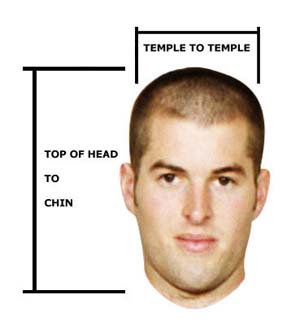
We know that different Goal Keepers like to wear their helmets in different ways, so all OBO Helmets come with an adhesive foam pad, which can be used to customise your helmet to suit your own preferences.
So depending on your head measurements here are the guidelines:
MEDIUM – If the width of your head is between 135mm and 150mm, and the length between 225mm and 235mm, you should get a medium.
We’ve found that heads about 135-145mm wide and 225-235mm long fit snugly into a medium helmet. Anything much over these dimensions starts getting pretty tight. So if either of your head measurements are larger than these, we recommend a large helmet with extra customised padding layers (particularly for those with short wide heads or long narrow ones – you can pad out the top or the sides as necessary).
If you’re still not sure about the sizing, please feel free to contact us with any questions you have, and we’ll be happy to advise you about which size helmet is appropriate for you.
Recently I've received some questions from people having problems with bonded foam separating in kickers and leg guards. First off, if your leg guards or kickers are under one year from time of purchase they should be under warranty. If that fits your situation, you should take the matter up with the agent who sold you your gear. If the pads are older than a year, than try this…
Recently I’ve received some questions from people having problems with bonded foam separating in kickers and leg guards. First off, if your leg guards or kickers are under one year from time of purchase they should be under warranty. If that fits your situation, you should take the matter up with the agent who sold you your gear. If the pads are older than a year, than try this…
For kickers:
Most splits I see with kickers are around the strap slots between the inner and outer face of the kicker. I know there are a couple of different glues that have been used successfully to bond the surfaces together. I’ve used Shoe Goo, Sports Goop and Gorilla Glue (brand name adhesives in the US) and know that OBO recommends using a hot glue gun. You can check at a hardware or home repair store for similar types of glue where you are. Clean the section you want to clean as much as possible by running hot water in the affected areas and then allow to completely dry. My experience has been that glue alone won’t hold. I use heavy duty landscape zip ties to reinforce then split areas. I’ll apply the glue (try to avoid getting glue in the strap slots) and then use an awl to punch a hole through the inner and out face of the kikcer as close to the strap slot as possible. Run the zip tie through the kicker so the notch where the tie is secured is on the inner face of the kicker. Pull the zip tie securely (the ties are self-tightening) and then cut the excess tail. You might have to use a couple of zip ties if you have a big split. Allow 24 hours for the glue to cure and keep the kicker straps loose until the glue is set.
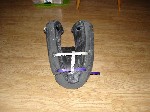 |
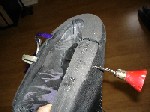 |
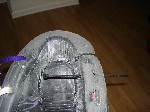 |
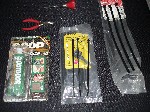 |
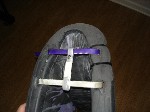 |
For Leg Guards:
You’ll need to bond the face of the leg guard to the channel that your leg fits (the outer to the inner). You can either use a hot glue gun or an adhesive. Whether you use Shoe Goo or a hot glue gun, apply adhesive liberally between the sections of foam (try to avoid getting glue in the slots where the straps run. Once the glue is applied you’ll want to reinforce the glued area with zip ties. Punch two holes through the face and channel of the leg guard about an inch apart and run the tie through the pad and pull tight. You’ll probably need more than one zip tie to securely fasten the glued area.
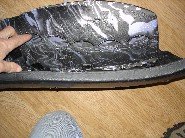 |
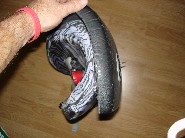 |
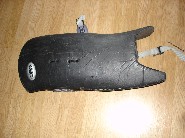 |
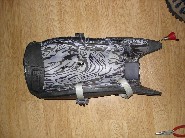 |
Good luck,
Jon
e-mail Jon
Please note that OBO together with Jon O’Haire hold copyright over any material appearing on tips pages. We welcome the printing and distribution of these tips, provided that they are not sold, or used for financial gain. This paragraph must appear on all printed or distributed copies. The photographs above must not be used in any form without express permission from Jon O’Haire.